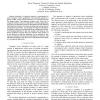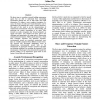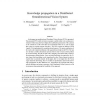153 search results - page 26 / 31 » A Feature Based Navigation System for an Autonomous Underwat... |
ICARCV
2008
IEEE
14 years 1 months ago
2008
IEEE
—Detection of spurious features is instrumental in many computer vision applications. The standard approach is feature based, where extracted features are matched between the ima...
TROB
2002
13 years 6 months ago
2002
Abstract-We describe Localization-Space Trails (LOST), a method that enables a team of robots to navigate between places of interest in an initially unknown environment using a tra...
AAAI
2008
13 years 9 months ago
2008
My thesis aims to contribute towards building autonomous agents that are able to understand their surrounding environment through the use of both audio and visual information. To ...
JIFS
2007
13 years 6 months ago
2007
In this paper an omnidirectional Distributed Vision System (DVS) is presented. The presented DVS is able to learn to navigate a mobile robot in its working environment without any...
ICRA
2002
IEEE
13 years 11 months ago
2002
IEEE
—The simultaneous localization and map building (SLAM) problem asks if it is possible for an autonomous vehicle to start in an unknown location in an unknown environment and then...



